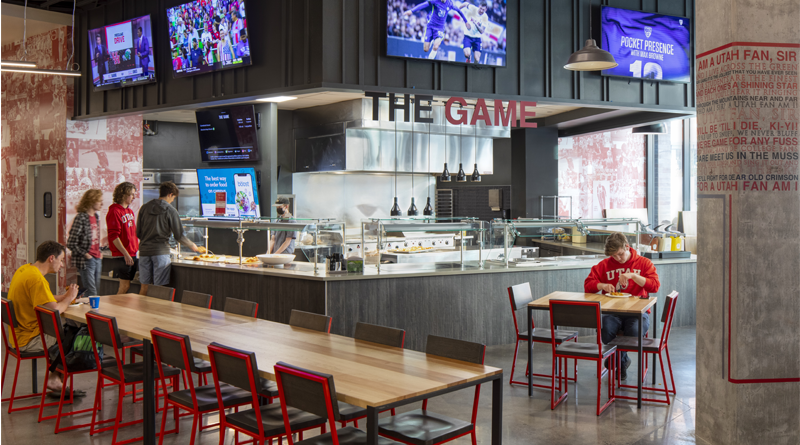Higher-Education Leaders Taking Inspiration from Hospitality
By Haley Costomiris
College students are notoriously not shy about voicing their opinions. So when it comes to how the pandemic and a year of remote learning changed their perception of campuses, it’s no surprise that we are hearing strong, polarizing thoughts on both sides of the spectrum. For some, tuning into a 9:00 a.m. biology lecture on a Friday morning from bed was a welcomed relief. However, for others, not experiencing the resources, collaboration, and energy that come from living in a tight-knit community mitigated students’ academic success and overall well-being.
But if there is something everyone (including faculty) can agree on, it is that the pandemic will likely change what students expect and want from their campuses in order to thrive academically and socially. Plus, after so many schools facilitated classes remotely throughout the pandemic, administrations are facing increased pressure to provide students with more amenities and resources on campus to justify the skyrocketing price tags of tuition.
To help design more dynamic and welcoming spaces, leaders in higher education are taking inspiration from the hospitality industry — as it is rooted in making guests feel like they are home, even if they are on the other side of the globe. When creating hotels, architects not only design rooms for guests to sleep in, but they also develop experiential elements, whether it is immersing in different lifestyles and traditions, hosting business meetings, or simply a place to wind down and escape. The same could be said for designing college campuses. Successful campuses are more than just a place to sleep and attend classes; they are also institutions to learn about various cultures, collaborate with peers and professors, and to make lifelong professional and personal relationships.
Prioritizing Inclusivity
In the wake of the pandemic, designing campuses that prioritize students’ well-being has arguably never been more important: according to a recent survey, 85% of students at colleges and universities reported increased stress and anxiety. Furthermore, students from conventionally disadvantaged communities, such as students who identify as BIPOC, are undocumented, female, or identify as a member of the LGBTQIA+ community, often rely on the services and resources available on college campuses for crucial support beyond academics.
Driven by a commitment to student wellbeing, more colleges are working with architecture firms with both higher education and hospitality expertise to specifically empower these often-marginalized populations alongside the general student body. For example, higher-education leaders and architects have created spaces to assist international and immigrant students. Placing facilities offering supportive services in the middle of campus with glass exterior walls highlights how these students are welcome and central to the campus community. To balance the gesture of transparency with the need for privacy, these buildings can also include strategically placed frosted windows or shades to protect confidential meetings from outsiders.
Implementing Flexible Spaces
While more colleges are focusing on enhancing spaces that empower traditionally underserved students, they are also looking to the hospitality industry for inspiration when designing the facilities and amenities that cater to all students. Even before COVID-19, hotels across the country were starting to rethink their shared and public spaces, including dining rooms, lobbies, front desks, and ballrooms. Specifically, as technology reduced the demand for conference rooms and allowed travelers to complete more tasks from their mobile devices, hotel designers reimagined these stagnant amenities as more flexible spaces that prioritize guests’ comfort and cater to a wider range of activities.
Following suit, more colleges are implementing these kinds of flexible spaces throughout their campuses, from dining halls to housing developments. Flexible spaces allow for more arrangements that support social distancing, along with supporting small and larger study groups. Furniture is also key to supporting flexibility: chairs and tables that feature charging ports and are light enough to easily move around are crucial to spaces that cater to varied purposes and events.
Kahlert Village, a recently completed housing community for almost 1,000 students attending the University of Utah, embodies these trends. The centerpiece of the community is the Village Hub, a residential center that activates the entire campus community from day to night with dynamic, multi-use spaces. Open to all students on campus, the Hub features a fireplace lounge, study rooms, a tech studio, meditation room, music rooms, and three classrooms. The dining room was also designed to serve a greater purpose: more than a place to eat, Kahlert Village’s dining facility inspires cross-cultural learning and creates a more cohesive and collaborative community. It features spaces for six food vendors to offer cuisines from around the globe, and breakfast kiosks that transform after peak meal hours to writing surfaces, converting the area into a space prime for studying and group projects.
Overall, the pandemic has changed the way we perceive and engage with the built environment in numerous areas of our lives, from the places we live to the areas we learn, socialize, and travel. As architecture trends shift across the board, current and future designers would be better served to tackle projects with a holistic approach to create more welcoming, dynamic, and inclusive spaces. Architects specializing in student housing and hospitality in particular share many of the same core values and goals, and therefore would benefit by continuing to collaborate and inspire each other.
Haley Costomiris is an Associate and Hospitality Design Leader with MHTN Architects.

